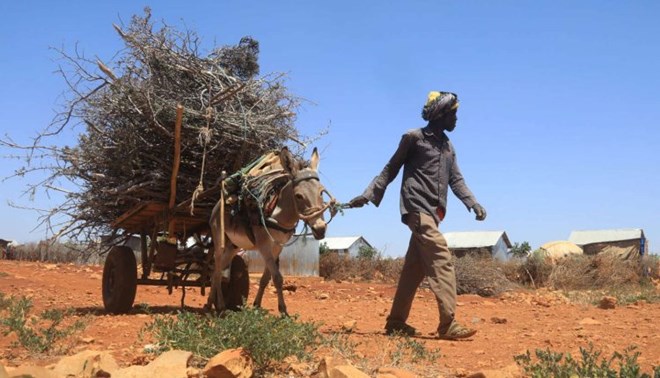
By David Sadler
Friday March 10, 2023

An internally displaced person in Barwaaqo, Somalia, February 21, 2023. FEISAL OMAR / REUTERS
According to the United Nations, 220,000 people could suffer from famine in Somalia this year, and 8.3 million are likely to face acute food insecurity. A huge challenge for humanitarian organizations working in the country. Director of the International Committee of the Red Cross (ICRC) for Somalia, Jürg Eglin nevertheless believes that “Somali society is more resilient” than previously.
Somalia has experienced several famines in thirty years. In your opinion, is the situation comparable to the crisis experienced by the country in the early 1990s?
I happened to be in Somalia during the famine of 1992. It was total anarchy, just after the collapse of the regime, when the warlords took over. Everything was broken. This political crisis, combined with a severe drought, had plunged many Somalis into an extremely difficult situation. But that was another era. What sticks in my mind is the misery and devastation that reigned in Mogadishu. The human suffering was enormous, very visible, and the mortality particularly high.
Today, the climatic situation is just as critical. For three years, the country has seen almost no rain. Humanitarian indicators are at their lowest. But Somalia is better equipped to deal with it. The state is not yet fully functional, of course, but society is more resilient. It relies on a solid network of private and business services that enable the delivery of aid to the communities. This is the reason why the country has not sunk despite the drama it is going through.
On the ground, what humanitarian response are international organizations able to provide?Somalia has experienced repeated humanitarian crises for three decades. The situation is either critical, or very critical, and sometimes even catastrophic. Unfortunately, more or less intense confrontations are added to natural disasters and droughts. Our added value within the ICRC is to be able to reach hard-to-reach areas and deal with groups that otherwise do not engage with international organizations. With the Al-Shabaab [organisation terroriste affiliée à Al-Qaïda], we try against all odds to have a humanitarian dialogue and to work for the populations who live under their control.
“The problem is that the Al-Shabaab still largely hold rural areas”
Somalia has been experiencing profound political changes for a year, starting with the coming to power of President Hassan Cheikh Mohamoud, who launched a vast counter-offensive against the Al-Shabaab. To what extent can this new political deal redraw the balance in the country?
My impressions on the ground are that there is a very dynamic new administration that has settled in Mogadishu. It’s very different from what I experienced thirty years ago, when the authorities were non-existent. The problem is that if you look at a map, the Al-Shabaab still largely hold the rural areas. In the countryside, access to public services is limited, people have to fend for themselves. There is a huge gap between the façade of big cities and the reality of other areas. The government’s task remains immense. As far as the ICRC is concerned, we do not interfere with political agendas and always maintain our position of neutrality.
Does the intensity of the ongoing counter-offensive against Al-Shabaab, often praised on the international scene, hinder the humanitarian response in Somalia to some extent?
Yes, and we must take it into account. The military offensive launched last year makes things unpredictable and forces us to react very quickly. Take for example the latest crisis, in Las Anod, in the north of the country [185 000 déplacés à cause d’un conflit communautaire depuis février] : the political dispute took an extremely violent turn; many internally displaced people are on the road. But we cannot intervene overnight. You have to knock on doors, get security guarantees, then send teams, assess and then help. The slightest misstep can put you in danger.
Somalia is one of the countries hit hardest by climate change. Are drought episodes likely to permanently change Somalia?
The future is dark. What society can rural Somali communities and internally displaced people invent? Climate change is gradually ending the semi-nomadic lifestyle of some Somalis. When cattle and grazing circuits are exhausted, whereas they are the base of these pastoral and clan societies, any return to this way of life seems compromised. What is the alternative? There are some projects to rationalize agriculture or manage herds, but not on a sufficient scale. If you fly over Somalia today, you realize that there are few of fertile land. To return to the situation of thirty years ago, two things would be needed: capital and stability. The conditions are not met.
In your opinion, is the crisis in the Horn of Africa (21 million people in need of food aid) overshadowed financially and in the media by the situation in Ukraine?
In Somalia, the ICRC had a very ambitious budget for 2022, of 120 million Swiss francs [environ 121 millions d’euros], which we paid for in full. Today, we are encountering great difficulties in financing our operations in Somalia. And more broadly, as an institution, we had a very difficult year in 2022 due to the various emergencies in Europe, Ukraine, but also due to inflation and donor priorities.
Noé Hochet-Bodin(Nairobi, correspondence)